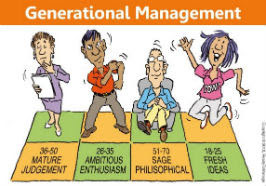 Generational Dynamics: Collaborative Styles for Intergenerational Team Building
Generational Dynamics: Collaborative Styles for Intergenerational Team Building
Article by Dr. Annika Hylmo in Generational Leadership, June 29, 2012
Going to meetings and working on teams takes up most of our working time. Different generations have different approaches to working on teams, so knowing when to connect and when to disconnect from each other without feeling resentful is important. Here are some ways that the generations approach collaboration differently:
Traditionalists – tend to collaborate in situations where everyone brings their unique expertise to the table. They like structured approaches to meetings, so setting and keeping agendas and timetables is appreciated. Traditionalists also tend to prefer meetings that are led by a designated leader, and that professional notes are typed up and distributed soon after to keep track of activities. That way, everyone can go back to their desks and complete tasks to be brought back on time prior to the next meeting.
Boomers – engage fully in collaboration. They appreciate the idea of collaborating on the job and will frequently be found chatting strategically about projects around the water cooler. To other generations, especially Generation X:ers, it often feels like Boomers want to overdo the number of meetings, but to the Boomers themselves it’s a great opportunity to make sure that everyone is up to speed and participating. Boomers have a more open meeting style compared to Traditionalists. While they may have an agenda they are likely to have a freer flow of conversation.
Generation X – is probably the most independent-minded of the generations and need to have good reason for collaborating. Once that reason is established, Generation X:ers will be as comfortable as anyone else participating. While often very innovative and good at brainstorming, Generation X:ers typically appreciate more structure than the Boomers, so that they can feel that something has been accomplished during a meeting. For that to happen, Generation X:ers like action steps and accountability metrics that tie meetings together. That way, and very similar to their Traditionalist colleagues, they can leave a collaborative session and do their parts independently before joining forces again.
Millennials or Generation Y – were born collaborators. They are accustomed to working on projects together where everyone is acknowledged individually for doing their part. Millennials appreciate being with older colleagues who can teach them while they work side-by-side on a small part of a larger project. Working together means getting to know one another. Many older colleagues are surprised by Millennials who want to have lunch together and talk about nothing that is work-related. For Millennials, that is a way to build trust and camaraderie necessary to do the job well. Millennials are also the most likely to use online collaborative platforms, from Skype to Google+, so be prepared for the suggestion that your team becomes at least partially virtual.
In addition to the different styles, be sure to think about some of the things that bring everyone together. Remember that everyone likes working and (hopefully!) especially working for your company on the projects or services that you offer. Everyone wants to do a good job, but might do it a little bit differently than someone older or younger. The outcome will still be the same – quality work and shared enjoyment of the process. Emphasizing that up front brings people together.
Related Resources
- Generational characteristics: A ReadyToManage Job Aid
- Generational Style Assessment (Online)
- Generational Differences in the Workplace Workshop Kit
